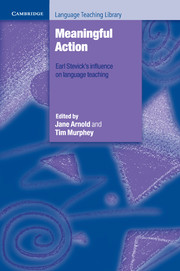Book contents
- Frontmatter
- Contents
- List of contributors
- Acknowledgements
- Preface
- Introduction
- Part A Meaning-making inside and between the people in the classroom
- Part B Meaningful classroom activity
- Part C Frameworks for meaningful language learning
- Epilogue: A way with words – perspectives on the contributions and influence of Earl W. Stevick
- Appendix: Words of tribute to Earl Stevick
- Index
17 - A dilemma of prediction: how teacher education is ‘piped’ to classroom teaching and student learning
Published online by Cambridge University Press: 15 November 2023
- Frontmatter
- Contents
- List of contributors
- Acknowledgements
- Preface
- Introduction
- Part A Meaning-making inside and between the people in the classroom
- Part B Meaningful classroom activity
- Part C Frameworks for meaningful language learning
- Epilogue: A way with words – perspectives on the contributions and influence of Earl W. Stevick
- Appendix: Words of tribute to Earl Stevick
- Index
Summary
Introduction
Drawing connections among complex human activities is a commonplace but imprecise undertaking. From economics to lifestyle choices to education, a great deal of time and energy is spent in trying to understand how one domain of activity may influence another. In this chapter, I explore one particular trajectory of these connections: those that try to link what teachers learn through professional education to what they do day to day in their classroom teaching; in essence, how teachers’ knowledge becomes available to their students. These connections are generally assumed but not often closely examined, the problem being that these three domains of activity – teacher education, classroom teaching and student learning – are distinct and yet interrelated. However, what happens in one domain cannot cause things to happen in the others. Therefore, characterizing the connections across them amounts to a matter of guesswork, which leads to the dilemma of prediction.
‘Piping’ as a metaphor for the problem of connection
In the second chapter of Teaching Languages: A Way and Ways, Earl Stevick begins his discussion of teaching with a story about religion, faith and access that offers a useful metaphor for this connection problem. The story is about a preacher at a revival meeting, which Stevick relates as follows: ‘When the time came to pass the collection plate, a man in the congregation stood up and shouted, “Hey Brother, I thought you said salvation is as free as the rain that falls from the heavens! Then why are you asking us for money?” To which the preacher replies, “Yes, Brother, salvation is … free … But you have to pay to have it piped to you!”’ (1980: 16). What is great about this story is how it distills the problem of instructed language learning and teaching. There is a contradiction in saying that to acquire things you can ‘get for free’, like religious beliefs or languages, you need to participate in organized settings, like churches or classrooms. But it is often the case.
The dilemma lies in how language teaching connects to language learning, since much of both contents (of teaching and of learning) can be ‘got for free’ in the world outside the classroom.
- Type
- Chapter
- Information
- Meaningful ActionEarl Stevick's Influence on Language Teaching, pp. 271 - 286Publisher: Cambridge University PressPrint publication year: 2013



